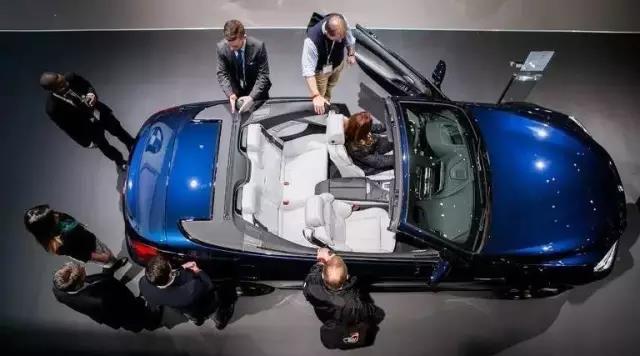
Introduction
The deeply-rooted automotive industry business model is experiencing disruption. Mobility needs previously satisfied through product “ownership” are increasingly being served through mobility services “usership”, with profound implications not only for traditional players within the value chain, but also for non-traditional players – as they enter and compete to deliver services. Mobility needs are increasingly being met through shared mobility services versus individual car ownership.
Disruptive new mobility services entrants are often linked to digital ecosystems which utilize big data analytics to draw insights about users based on their mobility patterns, diagnose their “pain points” and offer mobility and other digitally enabled solutions to address their daily needs.
In the past 5 years, mobility services have exploded in China, providing affordable and convenient transportation solutions to address the needs of an increasingly urbanized society. However, these solutions come with their own pain points, leading to further innovation and disruption by attracting capable entrepreneurs to provide better solutions and user experiences in the next era of China’s automobility revolution.
Drivers of Mobility Disruption in China
Connected mobility , a term which refers to “technology-enabled on-demand mobility services for moving people and goods from point A to B”, has become one of the most exciting developments in the history of the automotive industry.
It is a disruptive, paradigm-changing development because it requires a complete rethinking of the way to deliver value to the market. Traditional automakers must expand their focus from the product (the “automobile”), to the utility that is derived from the product (“automobility”), and create a business model and digital ecosystem optimized to provide digitally-enabled solutions for both car owners and users.
The “automobility” business model is highly embedded in an expanding digital ecosystem, capable of touching virtually all aspects of our connected lifestyle. In contrast with the traditional vehicle lifecycle-focused business model, the automobility business model is focused on connected mobility at the core of a user-centric digital ecosystem. (See Exhibit 1)
Exhibit 1
Future Automobility Industry
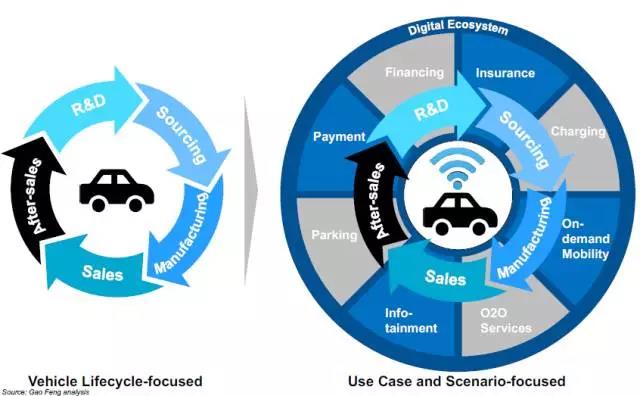
Compared with other markets, China exhibits far greater potential to disrupt and lead the automobility revolution. It is a market with far greater size and unparalleled complexity, where consumers are willing to try new services which make their lives more convenient. This provides a tremendous breeding ground for innovation.
First, China’s rapid urbanization has led to significant mobility challenges. With an urbanization rate of 56%, China’s urban population now exceeds 775 million people, and the transportation needs of this increasingly urbanized population have driven an explosive demand for personal mobility. With a vehicle population of over 190 million vehicles in 2016, individuals who own cars are still far outnumbered by those who do not, and mobility needs are increasingly served through mobility services “usership” versus personal car “ownership”.
Second, China has the world’s largest internet population and the vast majority of Chinese people are use mobile phones to access internet services. Chinese netizens have embraced connected lifestyles to access daily conveniences, including on-demand mobility (ODM) . Millennials in China have especially embraced the new business models enabled by such connected services.
Third, the Chinese government plays a key role to encourage innovation in the internet economy with a focus on the development of domestic automotive manufacturing, digital transformation, new energy vehicles and smart cities. The China government is seeking to use these disruptive trends as a path to establish leadership for the companies participating in the automobility revolution.
With a vibrant venture investment ecosystem and rising aspirations for home-grown entrepreneurship, China has become the world’s epicenter for the automobility revolution.
Three Phases of the Automobility Revolution
As previously noted, connected mobility forms the core of a user-centric digital ecosystem. The explosive growth in the popularity of mobility services in China acts as a force for transformation of the business model from vehicle-centric (focused on hardware ownership) to mobility-centric (focused on services usership). These services include mobility and other digital services which are offered based on the user’s connectivity and mobility patterns.
Exhibit 2
Three Phases of the Automobility Revolution
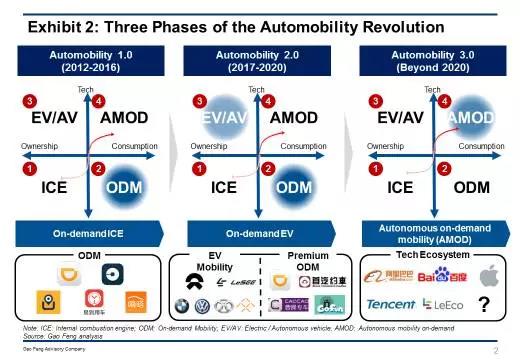
We believe we are witnessing a three-phase “Automobility Revolution”, which is rapidly transforming the competitive landscape. This landscape can be segmented into four quadrants along two axes, with “ownership vs. usership” along the horizontal axis and “technology” along the vertical axis. Four quadrants described by the predominant technology are shown in Exhibit 2:
1) Traditional internal combustion engine (ICE)
2) On-demand mobility (ODM)
3) Electric and/or autonomous vehicles (EV/AV)
4) Autonomous mobility on-demand (AMOD)
Quadrant 1 includes traditional OEMs, such as FAW, SAIC, BAIC, and many more. Several traditional automakers including Daimler, BMW, Volkswagen, BYD, Ford and General Motors are actively seeking to incorporate connected, electric and autonomous technology into their products and enter Quadrant 3, where Tesla has already established itself.
Quadrant 2 is currently populated with on-demand mobility service providers such as Didi Chuxing, Yidao, UCAR, Shouqi, Gofun and Caocao. More technologically advanced players in China such as NIO (formerly known as NextEV), Baidu, UISEE, Future Mobility Corporation and LeEco are experimenting in Quadrant 4 aiming to provide personalized mobility services, with the intention to compete in this domain with the likes of Google and Apple.
In China, the Automobility 1.0 phase (from 2012 to 2016) connected traditional cars (driven by humans and powered by an internal combustion engine) to riders using mobile technology. Pay-per-use ride hailing services, including Didi Dache, Kuaidi Dache, Yidao, Uber, and UCAR, were formed and grew rapidly. Stronger players like Didi Chuxing (a merger between Didi Dache and Kuaidi Dache), backed by technology firms such as Alibaba and Tencent, have become dominant. Other forms of connected mobility services including bike sharing (Mobike, Ofo, and many others) have also emerged and have grown rapidly.
We have recently entered the Automobility 2.0 phase. During this period, we will see cars built specifically for connected mobility services. The defining characteristics of cars used in this manner include high utilization rates and rider-centric features which enable connectivity. We expect such cars to be powered by electricity due to their lower operating cost (especially fuel and maintenance) and include features tailored for riders (more screens, connectivity and content services).
In addition, new business models and upgraded/differentiated on-demand mobility services will emerge to address mobility pain points observed in the Automobility 1.0 phase.
Beyond 2020, we will enter the Automobility 3.0 phase, when autonomous driving technologies will become commercially viable. An accelerated pull from China’s “Internet + Auto” and Smart City investments will result in the initial deployment of professionally managed mobility services fleets. The future automobility business model can be described by a combination of the terms “personalized, electric, shared and autonomous mobility on-demand”. Mass deployment of Autonomous Mobility On-Demand (AMOD) will occur beyond 2025 .
Automobility 1.0: Disrupting the White Space Between Ownership and Usership
Human beings are inherently explorers and some of history’s greatest inventions – wheels, bicycles, steamships, trains, cars, and airplanes – have allowed us to be conveyed faster and more affordably over greater and greater distances. Over time, each of these inventions added more and more convenience-oriented features to make the experience of mobility more “painless”. All forms of public and privately-owned transportation are solving this basic problem of minimizing our travel time.
Convenience shapes our choices when selecting among mobility options. Mobility devices are themselves a convenience which allow us to get where we want to be without walking. The choice of a mobility option is often made based on the distance of travel and the flexibility it offers (availability, convenience, comfort, and cost). Exhibit 3 illustrates the choices and trade-offs we must consider when selecting a mobility solution.
Each solution became commercially viable by offering a benefit versus other forms of transportation that individuals were willing to pay to “use” or “own”. For example, trains reduce travel time across a country from months to days, and commercial aviation reduced this to hours. We can now circle the world by jet in a little more than a day, a journey the first explorers could not complete in several years, if they lived to tell the tale.
Exhibit 3
Use Cases for Different Modes of Transportation
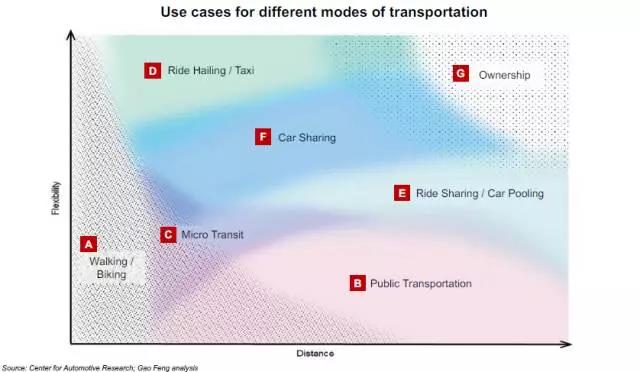
In recent history, owing to the invention of the internal combustion engine powered car (Carl Benz in 1886) and the moving assembly line (Henry Ford in 1908), car ownership became the standard means for the average person to satisfy their daily commuting needs.
In the increasingly urbanized and connected world of the 21st century, we are experiencing an “Automobility Revolution”, where new modes of mobility services are emerging rapidly and attacking the “white space” of mobility needs between public transportation and individual car ownership. This is happening particularly rapidly in China, where “riders” vastly outnumber “drivers” and individual car ownership is still in an early stage of adoption, which results in a mobility solutions segmentation as shown in Exhibit 4, where the number of riders/users at the bottom vastly outnumber the drivers/owners at the top (which is best visualized by a pyramid).
China’s Automobility Revolution is a story of disruption occurring in the whitespace between ownership and usership, which began in 2012 with the advent of On-Demand Mobility (ODM). Let us explore the brief history of ODM in China since 2012.
Exhibit 4
New Modes of Transportation in the “White Space” in China
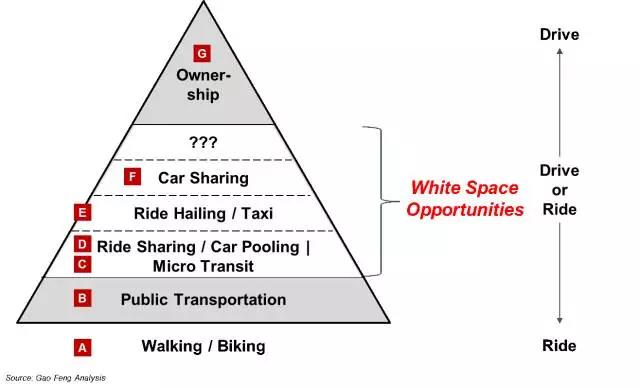
China’s Automobility 1.0 phase grew from taxi-hailing services, which used mobile technology (smart phone apps, GPS, algorithms to match riders with drivers, mobile payment) to address the pain points of hailing a ride, especially during peak demand periods. Many urban residents used ride hailing to upgrade from mass public transportation (metro, bus), seeking the better experience, convenience, and flexibility of this alternative.
Millions of urban residents upgraded to this form of personal mobility, resulting in demand far greater than the available capacity of municipal taxi services. This created a new white space opportunity for private car-hailing services to emerge in 2014, which offered another affordable upgrade option for taxi and public transportation users.
Taxi hailing started with Didi Dache (backed by Tencent) and Kuaidi Dache (backed by Alibaba) in 2012. These two separate companies merged in 2015 to become what is now known as Didi Chuxing (“Didi”). After consolidation, Didi has emerged as the dominant player for taxi hailing (with a near monopoly of this segment). Didi has also evolved from its original position as a taxi-hailing service to become a one-stop mobility service platform covering a wide range of mobility services including private car-hailing, car pooling, micro transit, car rental, and other car services (designated driver and test drive). In August 2016, Uber China merged with Didi, strengthening Didi’s leading position and they now also dominate China’s private car-hailing market (~87% market share).
Car Pooling (2014)
Car pooling offers users a lower-cost alternative to ride hailing, while still providing an upgraded mobility experience relative to mass public transportation. The China government is supporting this development to achieve higher efficiency through sharing of resources.

source: Baidu
By bundling high frequency commuters with similar mobility patterns, car pooling services can address the needs of both short and long distance commuters and travelers with predictable mobility patterns. Car pooling can also be positioned as a public utility, and thereby designed and operated in a manner that positions it affordably to encourage adoption and reduce surface congestion.
Dida Pinche is China’s leading car pooling platform designed with strong social elements. It connects underutilized assets to supplement carrying capacity and reduce congestion. At the same time, it creates a C2C social platform for passengers and drivers. Similarly, Didi Hitch, the car pooling platform of Didi, transported 8.48M passengers for inter-city trips during Chinese New Year in 2017.
Car Sharing (2014)
To increase the utilization rates and reduce the number of individually operated vehicles on the road, the China Government is encouraging timeshared car sharing services. Simultaneously, this is also being viewed as a channel for deployment of new energy vehicles, thereby accelerating the electrification of urban mobility services.
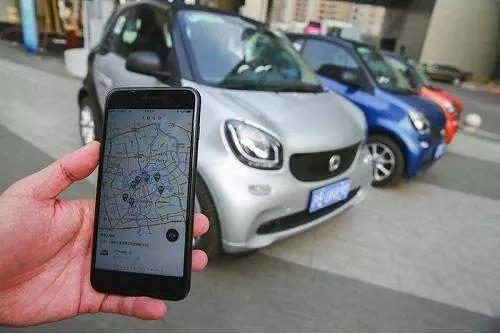
source: Baidu
The city of Beijing is deploying infrastructure for parking and charging for such EV car sharing services. In lower-tier cities, where individual car ownership is less prevalent, car sharing is supplementing the public transportation system. For example, Eakay has launched an EV car sharing service in Wuhu, a 3rd tier city in Anhui province, as a supplement to the limited local public transportation capacity.
Three operating models are emerging for car sharing. The first is the return at same location model, which is less flexible but easier to manage. GreenGo is an example of this. The second is return within the network with moderate flexibility and still easy to manage; EVCard is a leading operator in this category. The third is no fixed network where users can park anywhere in the city, which offers maximum flexibility but requires high operating costs. Car2Go is experimenting with this model in China.
Micro Transit (2015)
Micro transit, or bus pooling services, have emerged thanks in part to advancements in the technical algorithms used for matching of demand and supply. Such services target users seeking an upgraded experience versus mass public transportation, who also seek an affordable, reliable, and comfortable mobility experience. Dada Bus is a forerunner in providing a micro transit service which allows users to reserve a seat and check-in via their mobile device to access their work-home shuttle service. Didi also launched a Mini Bus pilot in late 2016, aiming to provide a comfortable last-mile mobility experience.
Bike Sharing (2016)
Free-floating bike sharing services are well positioned as a last-mile mobility solution. Mobike, the pioneering service founded in 2015, recorded 200M rides within their first 10 months, establishing a strong first-mover advantage.
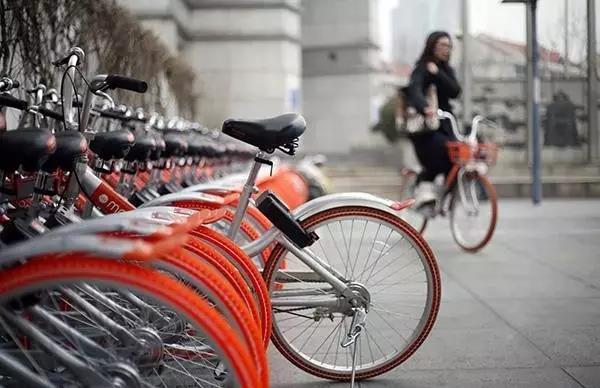
source: Baidu
Automobility 2.0: Finding the Blue Ocean within the Red Ocean
The intense competition for the opportunities in the whitespace between car ownership and public transportation can be accurately described as a “red ocean”. While offering China’s urban residents an increasing variety of comfortable, affordable and flexible choices to address their mobility needs, these new mobility services are themselves generating new pain points.
In the Automobility 2.0 era, innovative new solutions will emerge to address these new pain points, which we describe as finding the blue ocean within the red ocean. Let’s explore several pain points which have resulted from mass adoption of ODM services, and introduce several vivid examples describing the current experience of ODM in China.
Increased Congestion
Mobility pain is much higher in densely populated urban cities. While densely populated cities like New York, London, Paris, New Delhi, and Mexico City exist all over the world, the mobility experience in China is unique. Cities like Beijing experience gridlock conditions at several times during a day, and suffer from severe environmental impact from tailpipe and other emissions.
ODM services add to the problem of surface congestion by encouraging people to upgrade from mass public transportation to a personal mobility service. While comfortable for the rider, this effectively adds more cars on the surface streets, thereby compounding urban congestion.
Service Timeliness
Recent moves on the part of China’s government to regulate ride-hailing services have placed requirements on the type of vehicles and drivers. The immediate impact has been to reduce the available supply of cars, and users are experiencing longer wait times to book an available car during peak hours.
Surge Pricing
Early adopters were attracted to ODM as an affordable upgrade from public transportation. By introducing regulations that effectively restrict supply, users are finding it more difficult to get a car, especially during peak hours. ODM service providers have used this peak demand gap to introduce “surge pricing”, a time in which mobility services are much more expensive.
Service Inconsistency
By expanding the mobility services supply (drivers and vehicles) very rapidly, ODM service platforms have struggled to maintain service levels according to a consistent standard. The “minimum viable product” (an inspected vehicle and trained driver) is often difficult to maintain at a consistent level. Service quality is highly dependent on individual drivers and how well they can deliver a professional mobility services experience (typical ODM drivers are driving their first car and have only recently secured their license).
Safety and Security Concerns
Safety and security are major concerns, especially when you are putting yourself and your family into a vehicle with a person who you probably have never met before. Many ODM service users would not consider sending their children alone to school using a service. Also, personal information and data security are frequently cited as concerns when using connected mobility services.
Lack of Personalization
Vehicles used in ODM services today were not designed for this purpose. These cars were designed for the individual owner/driver prior to the Automobility 1.0 phase. Today’s cars are designed around providing a “cockpit experience”, primarily for drivers.
In the Automobility 2.0 phase and beyond, we will begin to see new features and purpose-built designs to allow personalization of the mobility services user experience. A “know me” personalized mobility experience for mobility service users is lacking in the delivery of the mobility services experience today.
Lack of Charging Infrastructure
Partly a result of favorable license plate availability, ODM fleets have a higher mix of electric vehicles. We believe that the China government will continue to favor EV adoption for these types of services to accelerate electrification. Mobility service fleet operators will also prefer electric vehicles due to lower maintenance and operating costs versus gasoline powered vehicles. However, the initial lack of charging infrastructure and concern over recharging downtime may limit large-scale deployment in the initial stage.
Inconvenient Parking
While this is limited only to the car sharing segment, a lack of parking space availability is a major pain point in China’s growing cities.
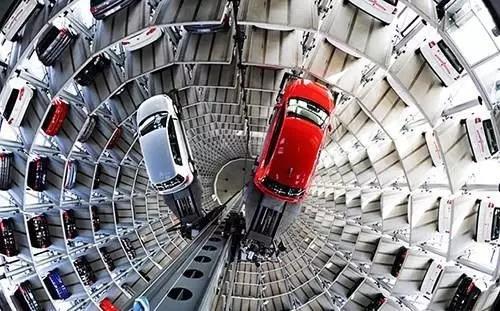
source: Baidu
As mobility is a basic need for commuters, city planners will be challenged to deploy fleets of highly utilized vehicles to efficiently serve the needs of the ever-expanding urban population. Encouraging people to use such services will require solutions for addressing these and other emerging pain points for the users of such services.
Vivid Examples: Mobility Services Pain Points
Jessica Wang, a 24-year old marketing specialist working in Zhongguancun Beijing, was trying to book a car to get home after work at 10pm on a rainy day. She had been waiting for 15 mins and no driver would accept her order as she declined to accept a 2.5X price surge. She walked 15 mins to take the metro instead.
Chen Lin, a 29-year old product manager working in Hangzhou, booked a taxi to get to an urgent client meeting. A taxi with a license plate different from the app showed up. Chen hopped on it and discovered that the driver was smoking. The driver was driving with one hand and texting to his friends on WeChat. Chen chose to tolerate it because he did not want to be late.
Xiaobing Wu, a 36-year old housewife living in Xintiandi Shanghai, booked a private car at 17:00 to visit a new Japanese restaurant which is 40 min driving distance away. It took 15 mins for the driver to find the pick-up point and the he had to check the GPS turn-by-turn navigation throughout the entire journey at an average speed of 15km/h. She arrived at 6:15 due to traffic congestion which could have been avoided.
Jack Xu, a 60-year old retired government official living in a suburban Hutong in Beijing, sold his car as he was frustrated with the cost and pain of ownership. He has been an avid user of a mobility service platform for 6 months, mainly for sending and picking up his grandson to and from school. He felt uncomfortable with entrusting his grandson’s life to the new driver who showed up today and expects more consistency and security for using a premium ride hailing service.
Automobility 3.0: Personalized and Autonomous Mobility on Demand
The exponential development of automobility services is leading to a new wave of innovation and disruption, attracting capable entrepreneurs and investors to create even better solutions and user experiences to address the pain points of mobility users.
Automobility users expect frequent and direct C2B interactions with the service provider, which creates new opportunities for monetizing the user relationship and branding the total mobility solutions experience.
Regular and sticky interactions with connected users of their digital ecosystem of solutions, along with their experimental problem-solving mindset, place Chinese BAT players in a strong position to drive the future automobility business model . Leading automobility players will rapidly evolve and deliver innovative mobility and digital services enabled with advanced vehicle technology.
Traditional automakers will struggle to keep up with the clock speed of the tech companies and are often conservative when pursuing new technological innovations, often waiting for a business case driven by an owner’s “willingness to pay” for new features in the car. They must learn to build digital mobility solutions ecosystem in collaboration with the tech companies that are targeting their place in the Automobility 3.0 domain where personalized and autonomous mobility on demand is available at the press of a button.
In addition, mobility services are not stand-alone businesses and have far-reaching social and economic impacts on people and cities. The market development will need to take careful consideration of the government’s national policies on smart city and intelligent transportation system, as well as the needs of local governments.
Adoption of autonomous driving technology linked with an intelligent transportation system will improve flow of traffic, reduce accidents and improve the quality of life in an increasingly urbanized world. Scaling up this technology through the convergence of On-Demand Mobility with electric and autonomous vehicles in these cities will accelerate a transition from a transportation model where we own an under-utilized asset that is used 1-2 hours per day to a model where autonomous cars, directed by a smart-city transportation grid, are deployed on demand to where they are needed.
Automobility 3.0 is a far more efficient system where instead of owning an under-utilized depreciating asset, people pay for the utility that is derived from the asset.
Conclusion
A uniquely challenging set of urban transportation challenges, a very high rate of mobile device connectivity, and a rapid and aggressive introduction of alternative mobility solutions have combined to make China a global breeding ground for mobility innovation.
Transportation innovation has throughout history helped improve how human beings experience the world, and China’s Automobility Revolution is a disruptive force that will transform the mobility experience for the world.
About the authors
Bill Russo is Managing Director and the Automotive Practice leader at Gao Feng Advisory Company based in Shanghai. With 15 years as an Automotive executive, including 13 years of experience in China and Asia, Mr. Russo has worked with numerous multi-national and local Chinese firms in the formulation and implementation of their global market and product strategies. He was previously Vice President of Chrysler North East Asia, where he managed the business operations for the Greater China and South Korea markets. Prior to this, Mr. Russo was Head of Product & Business Strategy for Chrysler. He also has nearly 12 years of experience in the electronics and IT industry, having worked at IBM Corporation as a manufacturing and systems engineer, and formerly served as Vice President of Corporate Development at Harman International.
Chee-Kiang Lim is a Principal at Gao Feng Advisory Company. He has over 20 years of experience, including 12 years of consulting experience in strategy development and operational improvement for large multinational corporations. His consulting work is focused on digital disruptions to traditional industries including automotive, insurance and energy sectors. He has also advised the Singapore Government on its Smart City strategy and implementation, and has deep expertise in the oil & gas, mining and high-tech industries in China, Southeast Asia and Australia. He has previously worked in telecoms and high-tech start-ups in the Boston area and in the Administrative Service of the Singapore Government.
Alan Chan is a Senior Consultant at Gao Feng Advisory Company based in Shanghai. He is a core member of the Gao Feng Digital, experienced in connected mobility, business model innovation and digital transformation strategy. He has worked in both multinational organizations and Internet start-ups across the Chinese Mainland, Hong Kong and the United Kingdom.
Jackie Tang is a Consultant at Gao Feng Advisory Company based in Shanghai. She provided strategy and operational consulting service to multinational and local clients and she is experienced in automotive and asset management industries, specializing in digital strategy formulation and innovative business model development.

